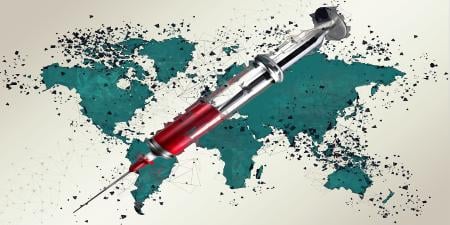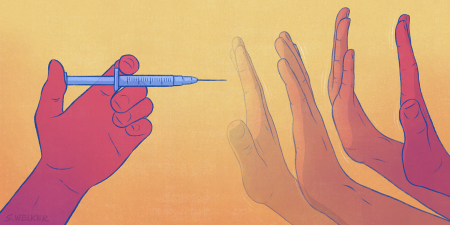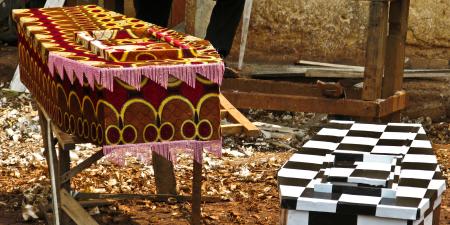Abstract
Biocontaining was one way that Western, affluent, allopathic cultures tended to respond and make meaning during the 2013-2015 Ebola virus disease (EVD) pandemic. It became a pathway to restore trust in biomedicine itself, which had been shaken by unease across the globe when the EVD threat was at its height. Yet biocontaining barely qualifies as a public health measure. Successful public health efforts rely on trust, which is difficult to maintain during a pandemic. Such efforts require balancing the need to be close to patients to care well for them against the need to remain distant from a virulent pathogen. Biocontainment tries to navigate this tension and, in so doing, simultaneously frustrates and supports public trust. This article suggests 5 things clinicians and health professions students should consider about the project of biocontainment that could affect their orientation to their public health duties.
Contagion Control Relies on Trust
While I was composing this article in mid-2019, 2 viral contagions were making headlines: measles and Ebola virus disease (EVD).1,2 A reliable intervention to render the measles virus harmless once it enters the human body does not exist, while 2 new drugs for Ebola show promise.3 Without prevention, the only treatment for measles is hydration and supportive care. Absent the drugs still in trial, the same is true for EVD. Either can be fatal. Measles is the more contagious of the two because it is both airborne and passed by direct contact. Coughing or sneezing does not spread EVD, but direct contact with it is more likely to be fatal.4 A protective vaccine exists for each virus, but both of them can be impotent in the context of public distrust. Bridling measles and EVD, especially as they can occur in combination, requires widespread conformity to public health advice and control measures, including vaccination.5
This article canvasses the role of biocontainment during the 2013-2015 outbreak of EVD in West Africa. Viewing biocontainment as part myth and part reality, this article shows how it is related to the most important priority in ethics for public health operations: establishing and maintaining trust.
Public Health’s Dual Orientation
Public health is both a branch of medicine and an arm of government. As the former it is not as gripping as the drama of biomedicine can be. Ironically, the historical success of public health efforts in the United States (think clean water and improved nutrition) render it amorphous and less visible. As an arm of government, public health is meant to benefit citizens.6 But enacting regulations to promote public health requires funding in the short run, while long-term benefits can be difficult to measure. Those making policy decisions and allocating funds might not be the ones who benefit directly.7 The US orientation to individualized health care overshadows public health almost completely, until a crisis like a measles outbreak occurs. Perhaps public health’s relative invisibility contributed to the surprising dazzle of biocontaining, an intervention that impressed the media with its exclusivity and expense and seemed to take public health to a whole new level.
Tantalizing New Response to Disease
During the EVD pandemic of 2013, the world saw a brand-new response to disease—biocontainment—demonstrated by a few resource-rich countries, notably the United States. Common forms of segregating persons known to be infected (such as isolation) or who might be infected to see if they manifest the disease (quarantine) paled in comparative appeal to the new shine of biocontainment. To biocontain was to render pristine a tiny section of a designated hospital—and then keep it that way—while inserting a dangerously infected patient into it. The emergence of biocontainment units and the publicity these units generated for their institutions and the enterprise of health care exhibited the full power of the biomedical project, as 3 resource-rich hospitals in the United States pulled out all the stops in terms of specialized staff, personal protective equipment, lab procedures, and waste management strategies displaying Western allopathic prowess in separating purity and contagion.8 In bald contrast were desperate public health efforts of resource-poor countries in West Africa to support EVD victims and contain disease. Ethically and clinically, the upshot here is that, although US biocontaining was highly publicized, it served only 9 patients, usually one at a time, of the thousands globally who contracted EVD.9
Biocontaining barely qualifies as a public health measure, and, in this sense, it is a myth.
Biocontaining was and is part reality and part myth. Combining extreme methods of isolation, personal protective equipment (PPE), and waste disposal, biocontainment efforts proved that persons infected with EVD could, under its strict constraints, be treated safely and reliably. In the 2013-2015 EVD crisis, this reality became a pathway to restoring faith in biomedicine itself, which had been shaken by the unease that overspread the globe when EVD was at its height.9 Biocontaining marked the first attempt to treat humans contaminated with the virus as if they were the virus—by clinicians adopting the many protective barriers for patient care that lab workers typically require when working with the most dangerous pathogens.
Yet biocontaining barely qualifies as a public health measure, and, in this sense, it is a myth. In the Occupational Safety and Health Administration’s hierarchy of controls, deploying PPE is the last resort, to be used only when 4 more effective interventions for virus containment have proven insufficient (elimination, substitution, engineering controls, and administrative controls).10 Biocontainment’s inferior ranking is well deserved due to its lack of scalability, its expense (rendering it useless in resource-poor settings), its ineffectiveness compared to other public health measures, and its potential for alienation—on a personal level, due to the appearance and enforced distances necessitated by PPE, and on a public-perception level, due to the small number of patients who can actually be served by it.
A Rock Star of Public Health Is Born
All the same, in 2014, biocontaining was a rock star in the world of public health. Some of the fascination came from its origins in combatting bioterrorism, which had given public health a shot in the arm. The anthrax attacks of 2001 galvanized government agencies to prepare for biowarfare,7 and biocontainment units were born. Like biomedicine itself, biocontaining requires atomization and strives to isolate a singular object, emblematic of scientific research.11 In comparison to the tidiness of scientific objectivity, routine public health seems messy, inexact, and unrefined. Yet it was the integration of public health protocols and community buy-in that, in the absence of a vaccine, finally halted EVD and saved countless lives during the 2013-2015 outbreak.12
Need for Trust in Public Health
The Centers for Disease Control and Prevention counts new vaccines for vaccine-preventable diseases as among the most effective public health interventions of the 20th century.13Resistance to vaccination is a factor in both measles and EVD outbreaks.14,15 It is my purpose here not to reiterate the science and merits of vaccination but rather to call attention to a deeper issue central to vaccination’s success.
When a disease outbreak occurs, something far more mundane and complex than biocontaining and even vaccination must take center stage: establishing and maintaining trust in order to support humans and their relationships. Leaders of pluralistic societies typically struggle to define who is “us” and who is “other,” as do those they represent. In the face of public contagion and fear of contamination, tension between us and other is starkly visible, and line-drawing has high ethical, social, and cultural stakes. We want to protect ourselves and our loved ones from danger. But the sick and the potentially sick are both us and other—simultaneously dearly loved and highly dangerous. This tension is heartbreakingly evident in cases of a hemorrhagic fever like EVD, in which suffering is so evident and the need to be close to deliver care or prepare for burial is both compelling and menacing. What role does and should trust play in balancing our need to be close and our need—in accord with public health measures of disease containment—to be distant?
Childress et al describe 9 “general moral considerations” in public health, among them respecting autonomy, fidelity, and minimizing intrusion.6 Trust, though listed last, is foundational to the other eight. Without confident relationships among policymakers, clinicians, and members of the public, public health efforts such as vaccination are doomed to failure. Accordingly, clinicians and health professions students should implement 5 lessons from the phenomenon of biocontaining when they are responding to or planning for a pandemic, because in doing so they might be better able to connect public health duties to social relationships and thereby cement trust.
5 Lessons From Biocontaining
In view of 2019’s active threats of contagion, it makes sense to ask, What are the top 5 things clinicians and health professions students should consider about biocontaining that could affect how they orient themselves to their public health duties? This question is critical if biocontaining cannot, due to its infrastructure demands and cost, be a safety net in a pandemic, despite its evident appeal.
- Violence, tribalism, and stigma disrupt and destabilize society. These factors complicate public health efforts because they enfeeble trust. Clinicians must avoid “othering” either victims or nonconformists (such as those who resist vaccination) in personal reflection and in communication. Pandemic-related efforts must ensure social and financial support for those separated for observation or quarantine.16
- Narrative medicine is a model. Charon encourages consideration of the multilayered context between physician and patient16; public health workers must attend carefully to context as well. As particular localities and constituencies involve themselves in pandemic response, the stakes and the networking challenges for outside responders mushroom. Collaborative authority17 can be achieved by inviting and welcoming community members’ input and fully incorporating it in decision making.18 The goal is a public health effort that “expresses community”6 rather than imposes naked governmental authority.
- Disbelief in the public health messages comes from lack of faith in the messenger, especially if she or he is “other.” In the Democratic Republic of the Congo, the public health response to EVD is occurring amidst social upheaval, and rumors fly that Ebola itself is a fabrication.15 Vaccination cannot save people when a threat seems ephemeral or “cooked up.” Trust is necessary for both the message to express community and the messenger to build collaborative authority.19 Public messaging can raise awareness while reducing stigma and avoiding blame.
- Demonstrating fairness is a priority for trust. How can clinicians work to close the gap between resource-rich and resource-poor environments when treating EVD? Tapping into community knowledge and leadership can demonstrate collaborative authority to address this requirement locally. Yet, as the world shrinks, outbreaks anywhere on the globe affect both us and other. Enlightened self-interest can motivate striving for and achieving equity in distributing public health containment measures.
- Biocontaining simultaneously supports and frustrates public trust. Biocontaining is trustworthy in terms of its effectiveness as a last resort. But it is also inequitable in terms of its accessibility, thereby subverting trust. The required investment in physical resources, setting, training, and staff to implement it fully is out of reach for most health care delivery systems in the world. Hospitals with biocontainment facilities can admit only miniscule numbers of patients. Favoring so few with specialized, sought-after care during a pandemic will challenge public health triage methods unimaginably.
References
-
Borter G. US records 33 new measles cases, mostly in New York State. Reuters. June 24, 2019. https://www.reuters.com/article/us-usa-measles/us-records-33-new-measles-cases-mostly-in-new-york-state-idUSKCN1TP1RB. Accessed July 10, 2019.
-
Hayden S. How misinformation is making it almost impossible to contain the Ebola outbreak in DRC. Time. June 20, 2019. https://time.com/5609718/rumors-spread-ebola-drc/. Accessed on July 10, 2019.
-
World Health Organization. Update on Ebola drug trial: two strong performers identified. https://www.who.int/news-room/detail/12-08-2019-update-on-ebola-drug-trial-two-strong-performers-identified. Published August 12, 2019. Accessed October 1, 2019.
-
Kaiser Family Foundation. Ebola: five key questions. https://www.kff.org/infographic/ebola-characteristics-and-comparisons-to-other-infectious-diseases/. Published May 14, 2018. Accessed October 1, 2019.
-
Mole B. Measles is killing more people in the DRC than Ebola—and faster. Ars Technica. July 15, 2019. https://arstechnica.com/science/2019/07/measles-is-killing-more-people-in-the-drc-than-ebola-and-faster/. Accessed October 1, 2019.
- Childress JF, Faden RR, Gaare RD, et al. Public health ethics: mapping the terrain. J Law Med Ethics. 2002;30(2):170-178.
-
Schneider MJ. Introduction to Public Health. 5th ed. Burlington, MA: Jones & Bartlett Learning; 2017.
-
Douglas M. Purity and Danger: An Analysis of the Concepts of Pollution and Taboo. New York, NY: Routledge; 1966.
- Chapple HS, Schenck D. Biocontaining: purification, restoration, and meaning-making. Perspect Biol Med. 2017;60(2):166-185.
-
National Institute for Occupational Safety and Health (NIOSH), Centers for Disease Control and Prevention. Hierarchy of controls. https://www.cdc.gov/niosh/topics/hierarchy/default.html. Reviewed January 13, 2015. Accessed August 26, 2019.
-
Gordon D. Tenacious assumptions in Western medicine. In Locke M, Gordon D, eds. Biomedicine Examined. Dordrecht, The Netherlands: Kluwer Academic Publishers; 1988:19-56.
-
World Health Organization. What needs to happen in 2015. https://www.who.int/csr/disease/ebola/one-year-report/response-in-2015/en/. Published January 2015. Accessed October 2, 2019.
-
Ten great public health achievements—United States, 2001-2010. MMWR Morb Mortal Wkly Rep (MMWR). 2011;60(19):619-623.
-
Infectious Diseases Society of America. Measles vaccination: myths and facts. https://www.idsociety.org/public-health/measles/myths-and-facts/. Accessed October 2, 2019.
- Vinck P, Pham PN, Bindu KK, Bedford J, Niles EJ. Institutional trust and misinformation in the response to the 2018-19 Ebola outbreak in North Kivu, DR Congo: a population-based survey. Lancet Infect Dis. 2019;19(5):529-536.
- Merkel H, Gostin LO, Fidler DP. Extensively drug-resistant tuberculosis: an isolation order, public health powers, and a global crisis. JAMA. 2007;298(1):83-86.
- Charon R. Narrative medicine: a model for empathy, reflection, profession, and trust. JAMA. 2001;286(15):1897-1901.
- Nembhard IM, Edmondson AC. Making it safe: the effects of leader inclusiveness on psychological safety and improvement efforts in healthcare teams. J Organ Behav. 2006;27(7):941-966.
-
Centers for Disease Control and Prevention. Dikembe Mutombo Ebola PSA [video]. https://www.cdc.gov/vhf/ebola/outbreaks/drc/Dikembe-Mutombo-Ebola-PSA.html. Reviewed June 20, 2019. Accessed October 2, 2019.



